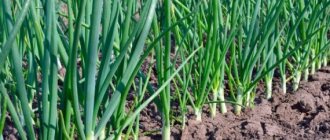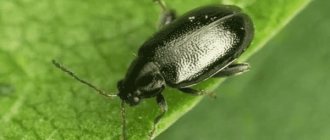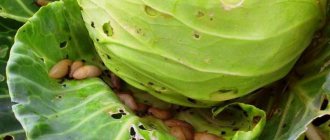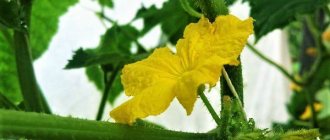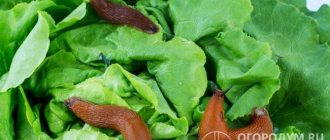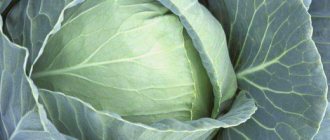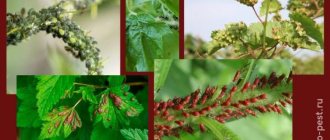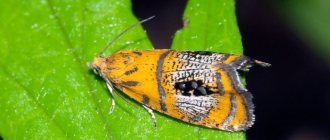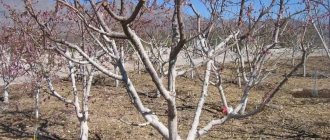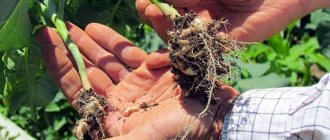Aphids are a real scourge for our gardens and vegetable gardens! Already from spring in the greenhouse and from July in the open ground, summer residents invariably face the problem of combating this extremely voracious and prolific pest. And this must be done in a very short time, literally within a week, since it is in such a minimum time that the melon aphid can completely drive it into trouble, destroying a significant part of the crop. It is then that well-thought-out and time-tested folk remedies, as well as fairly constructive biological and chemical methods of struggle, become of great importance.
Well, then we’ll talk in detail about how to get rid of aphids on cucumbers in a greenhouse and open ground.
What are aphids and how are they dangerous for plants, including cucumbers?
There are many types of aphids. Pumpkin crops, including cucumbers, are affected by melon aphids. Cabbage, legumes (beans, peas) and tomatoes, eggplants, and peppers also suffer from aphids.
The pest reaches no more than 2 mm in length, and it multiplies very quickly, occupying all garden beds in a matter of days.
The melon aphid damages the leaves and young shoots by piercing them and sucking the juice from the plants. As a result, the shoots stop growing, stop forming fruits, and the plant soon dies.
In addition, aphids are carriers of dangerous viral diseases, which can cause the death of neighboring crops.
The pest settles on the back side of the leaves, so it can be replaced at the wrong time.
Signs of aphids on cucumbers:
- the edges of the leaves curl down;
- deformation of the tops of the stems occurs;
- the plant stops growing;
- internodes are shortened;
- fruit formation is reduced;
- plants are covered with honeydew;
- ants appear;
- the ovaries fall off;
- the lower leaves wither;
- Small black bugs appeared on the back of the leaves.
Reasons for appearance
Ants are the main “friends” of aphids and the main reason for their appearance. They feed on sweet dew, which is released by pests during their life processes. As they move, the ants carry aphid larvae on themselves, spreading them throughout the garden. Therefore, protective measures must be taken against them. Pests also appear due to the following violations of agrotechnical rules:
- poorly prepared soil before planting;
- non-compliance with crop rotation;
- untimely weeding (weed growth);
- dense plantings of cucumber bushes;
- poor ventilation (for greenhouses);
- increased nitrogen content in the soil.
In addition, you can bring aphids into a greenhouse or outdoor garden bed yourself. For example, insect eggs live on weeds, which are used for mulch.
How to treat cucumbers against aphids: folk methods of fighting aphids on cucumbers
Important! To completely destroy melon aphids on cucumbers, it is necessary to carry out 2-3 treatments with an interval of 3-4 days. At the same time, various folk remedies are used so that the pest cannot adapt to them.
Treatment of cucumbers against aphids is carried out in the evening after sunset on the back side of the leaves.
Ammonia (ammonia solution)
10% ammonia effectively fights aphids.
Solution recipe:
- 10 liters of water;
- 50 ml. ammonia;
- 5 tbsp. spoons of liquid laundry soap;
- 3 tbsp. spoons of sunflower oil.
Interesting! Liquid soap enhances the adhesion of the solution to the leaves, and oil enhances the effectiveness of the product.
Mustard powder
Mustard powder is good for controlling aphids. The solution is prepared as follows:
- 100 g powder;
- 3 liters of boiling water;
- Leave for 5-6 hours (stirring occasionally);
- after the mustard settles, the liquid is poured into a 10-liter sprayer
- add 5 tbsp. spoons of liquid laundry soap;
- 3 tbsp. spoons of sunflower oil;
- 7 liters of water.
- Spraying is carried out.
Soda
Baking soda works great against aphids. Preparation of the solution:
- 10 liters of water;
- 50 g of soda (3 tablespoons);
- 5 tbsp. spoons of liquid laundry soap;
- 3 tbsp. spoons of sunflower oil.
Interesting! Soda solution is also effective against powdery mildew and rot.
Vinegar
To treat cucumbers against aphids, prepare the following solution:
- 1 tbsp. spoon of acetic acid;
- 1 liter of water;
- 1 tbsp. spoon of laundry soap or detergent.
In further recipes you need to add soap, but you can discard the oil.
Wood ash
- 200 g of ash;
- 10 liters of water;
- stand for 12 hours;
- then add 2-3 tbsp. spoons of soap, grated.
Interesting! Products based on plants that emit a pungent odor are effective: celandine, garlic, onion skins and others.
Laundry or tar soap
- Finely grate 100 g of soap;
- pour 10 liters of water.
Garlic
- 150 g crushed;
- add to 10 liters of boiling water;
- stand for 24 hours;
- filter.
Onion peel
- 200 g husk;
- 10 liters of water;
- stand for 4-5 days;
- strain.
Pine needle extract
- 1 tbsp. spoon of extract;
- 2-3 tbsp. spoons of liquid soap;
- a bucket of water.
Tobacco dust
- 2 cups of tobacco dust;
- 10 liters of water;
- Infuse for 1 day;
- filter;
- add 50 g of crushed laundry soap.
In the same way, you can prepare not an infusion, but a decoction. In this case, the mixture will need to be simmered for 30 minutes after boiling.
Tops of tomatoes and potatoes
- 3 liter jar.
- Fill it ½ full with tops.
- Boiling water is poured to the brim.
- They insist for a day.
- Rub 1 tbsp. a spoonful of laundry soap.
Celandine
Infusion of celandine is an effective remedy for aphids on cucumbers.
- 3-4 kg of freshly cut green grass or 1 kg of dry;
- 10 liters of water;
- stand for 1-2 days;
- filter;
- add 2-3 tbsp. spoons of soap (grate).
Yarrow
- 1 kg of flowers and leaves;
- fill the bucket with boiling water to the brim;
- leave for 4-5 days;
- drain the liquid into another container;
- add 2-3 tablespoons of previously crushed soap to it.
Chamomile
- 10 liters of boiling water;
- 1 kg of pharmaceutical chamomile;
- leave for 12 hours.
- dilute with water 1:3;
- rub laundry soap (40 g per 10 liters of solution).
Sorrel
- 300 g horse sorrel roots;
- 10 liters of boiling water;
- Infuse for 2 hours;
- filter and spray.
Types of parasites on plants
In European countries, scientists have discovered about 1 thousand species of aphids - plant pests that feed on their juices and also spread various diseases. This is a small bug, 1-2 mm in size, with a variety of colors: straw yellow, green, brown or black. With the help of a proboscis, she pierces the leaf and sucks beneficial juices from it. They live in large colonies, so in a few days they can destroy almost the entire leaf part of the plant.
What do aphids look like on cucumbers? This is a cluster of small insects of different colors, often green, that sit on cucumbers at the bottom of the leaves.
Important!
The main enemy of aphids is ladybugs, which are capable of eating more than 50 individuals per day, so they can be released into the greenhouse to combat the pest. Some insects also like to eat it: lacewings, gall midges, wasps.
Aphids on cucumbers in a greenhouse can cause irreparable damage to the plants themselves, their ovaries and flowers in a short time, as a result of which fruiting stops. It poses a particularly great threat when it settles on cucumber seedlings. By secreting sweet honeydew, parasites attract certain insects. They are especially loved by ants, who form a symbiosis with pests: dragging them onto other plants, gradually infecting everything around them. In winter, ants provide shelter to the “breadwinners” in their colony.
Aphids on cucumbers
The most common type of this pest is the melon aphid, which has 2 development phases: regular and winged. Wingless individuals reproduce directly on plants, while winged ones fly a short distance, finding new places to settle and feed. They live not only on cucumbers and tomatoes, but also on carrots, zucchini and pumpkin, and berry bushes, so it is better to plant such crops away from each other.
Biological agents
If aphids have already infected many cucumber plantings, then it is necessary to resort to treatment with special fungicides: biological and chemical. Effective biological preparations for controlling aphids on cucumbers include the following:
- Bitoxibacillin;
- Aktofit;
- Biotlin;
- Fitoverm.
Fitoverm allows you to destroy pests very quickly: 2 hours after treatment they stop feeding, and after 2 days they die.
You can also use “Healthy Garden” against aphids, the main thing is to double the dosage - 4 granules per 1 liter of water). It lasts for 2-3 weeks, after which you can spray it again.
Moreover, already 3-5 days after processing, the fruits can be used for food again.
Symptoms of infection
Most often, the provocateur of the appearance and reproduction of these pests on the site is the gardener himself, thickening the beds or greenhouses, not removing weeds in a timely manner, ignoring the appearance of a large number of ants.
You can recognize a pest attack on cucumbers by the following signs:
- the growth and development of the plant stops, internodes are shortened;
- the activity of flowering and fruiting decreases, the ovaries fall off;
- cucumber leaves begin to curl, the lower ones wither;
- sticky drops (honey dew) appear on the foliage and stems - a waste product of insects;
- the tops of the main stem and lateral branches are deformed;
- Ants appear around the cucumber plot.
If you notice one or more of the listed symptoms, you should immediately examine the cucumbers. Aphids are located on the underside of leaves, sometimes crawl onto trunks, and make their way into buds. Rarely occurs on fruits. The choice of spraying agent for the plant depends on the intensity of the infection.
Related article:
When to plant gladioli in open ground in spring, how to do it correctly
Even if it is impossible to save the plantings, treatment will have to be carried out. Affected plants are removed from the site, burned outside, and the soil is sprayed with insecticides.
Chemicals
Most often, after several treatments of cucumbers with folk or biological remedies, the aphids disappear. However, it happens that the pest remains. Then it is necessary to use chemical insecticides: systemic or surface.
| Name | Consumption rates, 10 l of water | After treatment, wait days before harvesting | Peculiarities |
| Inta-vir | 1 tab | 3 | do not use during flowering, toxic to bees |
| Aktellik | 3-15 ml | 20 | |
| Karbofos | 10 ml | 20 | |
| Spark Bio | 77 ml | 2 | |
| Iskra M | 10 ml | 20 | |
| Iskra Golden | 5 ml | 3 | |
| Fufanon | 10 ml | 20 | |
| Fufanon-Nova | 13 ml | 2 | |
| Commander | 5 ml | 3 |
The disadvantage of using chemicals is the long wait time for the substance to be removed. That is, the fruits can be eaten only 3-4 weeks after processing. Before this, the fruits will need to be picked and thrown away.
Help from beneficial insects
The aphid is afraid of some of its fellows, who devour it. Therefore, you can fight the pest with the help of these representatives of the insect kingdom.
ladybugs
These pleasant, cute bugs happily feed on aphids and their larvae. Please note that you can now purchase ladybug larvae in garden stores: this way you will multiply beneficial bugs much faster.
ladybugs
If you cannot buy ladybird larvae on sale, then adult insects can be collected outside the greenhouse and then released inside. But you can find out how to use the remedy against the Colorado potato beetle Prestige from the article.
Hoverflies
These flying insects also feed on aphids. To prevent flies from entering the greenhouse, you can plant plants inside with an attractive scent to insects, such as fennel, parsley or dill.
Hoverflies
Advice from expert gardeners on preventive measures
Experienced gardeners recommend the following to prevent aphids on cucumbers:
- Regularly inspect the back of the leaves.
- If there are any signs of infection, treat with folk remedies.
- If traditional methods do not produce results, use biological and chemical agents.
- Regularly apply potassium-phosphorus fertilizers.
- At the same time, you need to fight the ants.
- Remove weeds in a timely manner.
- Immediately remove and burn the affected parts of the plant.
- Wash the bushes before flowering by sprinkling.
- Varieties that are resistant to insects are grown.
- Protect ventilation openings in greenhouses with mesh or gauze.
- Cover the cucumbers with a thin cloth in the open ground.
- Treat seeds and soil before sowing.
- In the fall, disinfect the greenhouse with sulfur bombs.
- Change spraying preparations so that the pest does not adapt to them.
- Do not thicken the plantings.
Using various means and preparations to combat aphids on cucumbers, you can choose the optimal ones that will allow you to get rid of the malicious pest and save your crop.
Watch the video! Aphids on cucumbers: the best ways to fight them
Preventive measures
First of all, you need to remember that preventive measures will help minimize the risk of infection, as well as identify the problem at an early stage and quickly eliminate it. When purchasing seedlings, you need to carefully examine them; if some samples are suspicious, they are sent to quarantine.
Experienced gardeners recommend adhering to the rules of agricultural technology, maintaining the correct temperature in the greenhouse and humidity level. When the rules of cultivation are violated, this is reflected in the condition of the cucumbers; the plants are weak and susceptible.
It is better to choose resistant varieties that are undemanding in care. Since aphid larvae are often found on weeds, the area should be cleared of weeds. Remember that real breeding grounds for aphids are plants such as sunflower, mallow, poppy, chrysanthemum, and nasturtium.
In the fall, it is necessary to cultivate the soil and disinfect it. For this you can use Bordeaux mixture, karbofos, lime. You should also treat the greenhouses; in this case, a sulfur bomb works well. Starting from spring until autumn, it is necessary to treat the plantings with Fitoverm solution, the procedure is carried out every 3 weeks.
Carefully inspect areas for the presence of anthills. If found, you should dig up the area, sprinkle soda, lime or ash on top, then pour boiling water over it. You can purchase specialized ant repellents.
In the fall, when the preparation of the greenhouse begins, dry mixtures should be added; phosphorus-potassium mixtures are ideal.
